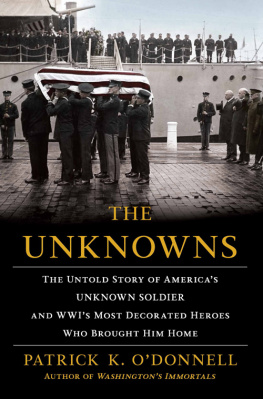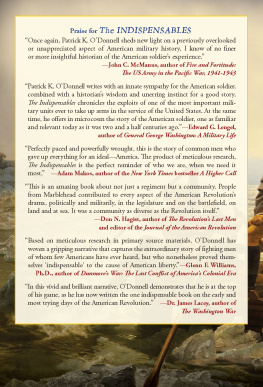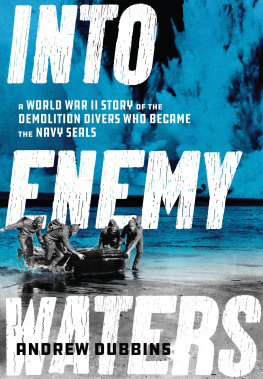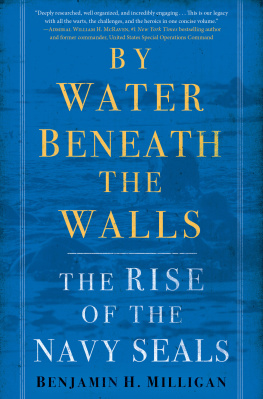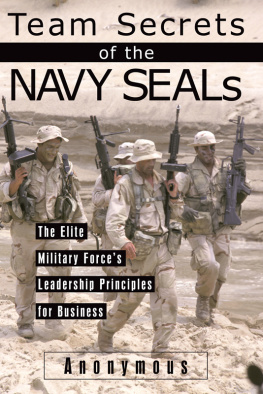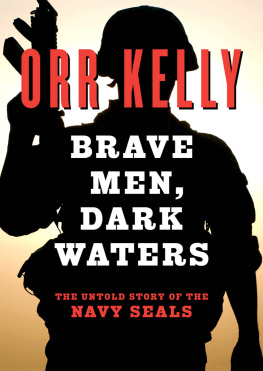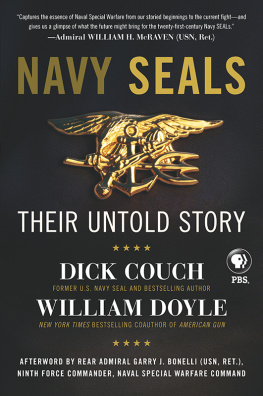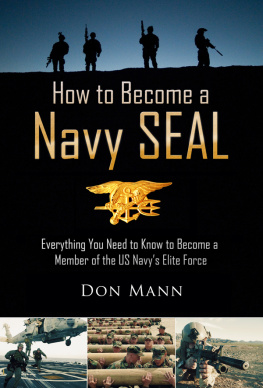FIRST SEALS

Copyright 2014 by Patrick K. ODonnell
All rights reserved. No part of this publication may be reproduced, stored in a retrieval system, or transmitted, in any form or by any means, electronic, mechanical, photocopying, recording, or otherwise, without the prior written permission of the publisher. For information, address Da Capo Press, 44 Farnsworth Street, 3rd Floor, Boston, MA 02210.
Book design by Cynthia Young
Library of Congress Cataloging-in-Publication Data
ODonnell, Patrick K., 1969
First SEALs : the untold story of the forging of Americas most elite unit / Patrick K. ODonnell. First edition.
pages cm
Includes bibliographical references and index.
ISBN 978-0-306-82173-8 (e-book)
1. World War, 19391945Commando operationsUnited States. 2. United States. NavyCommando troopsHistory. 3. United States. Navy. SEALsHistory. 4. United States. Navy. Underwater Demolition TeamsHistory. 5. United States. Office of Strategic ServicesHistory. 6. World War, 19391945CampaignsMediterranean Region. 7. World War, 19391945CampaignsItaly. 8. World War, 1939-1945CampaignsAustria. 9. World War, 19391945Amphibious operations. I. Title. II. Title: First SEALs, the untold story.
D794.5.O37 2014
940.54'8673dc23
2014026097
First Da Capo Press edition 2014
Published by Da Capo Press
A Member of the Perseus Books Group
www.dacapopress.com
Da Capo Press books are available at special discounts for bulk purchases in the U.S. by corporations, institutions, and other organizations. For more information, please contact the Special Markets Department at the Perseus Books Group, 2300 Chestnut Street, Suite 200, Philadelphia, PA 19103, or call (800) 810-4145, ext. 5000, or e-mail .
10 9 8 7 6 5 4 3 2 1
To Jack Taylor and the renaissance men of the Maritime Unit

To Lily
To Dawn
CONTENTS



BEGINNING IN THE SUMMER OF 1942, an extraordinary group of men embarked on an experiment that would alter the course of modern warfare. A dentist, a Hollywood star, a British World War I veteran, an archaeologist, California surfers, a medical student, and even former enemies of America united to pioneer U.S. Sea, Air, and Land operations. They combined intelligence gathering with special operations, much like todays Navy SEALs. Known as the Maritime Unit, these were Americas first swimmer commandos, an elite breed of warrior-spies decades ahead of their time. Technically, there were no SEALs in World War II, as the unit officially formed in 1962. But the Maritime Unit bent the norm to create tactics, technology, and a philosophy that live on in the modern U.S. Navy SEALs and shape the battlefield of today. No other American World War II unit was quite like it.
The men of the Maritime Unit maintained their vows of silence. Their story was classified, lost, and buried in miles of warehoused government records. Now, the World War II generation is in its twilight, and the last of these extraordinary men are slowly fading away.
This is their story.
NOVEMBER 1942, SHOREHAM HOTEL, WASHINGTON, D.C.
At the intersection of Connecticut Avenue and Calvert Street in Washington, D.C., stands the well-appointed Shoreham Hotel. Built in 1930, the impressive art deco structure boasts 832 luxurious guest rooms, several elegantly furnished ballrooms, high-ceilinged dining rooms, and a sumptuous lobby illuminated by a host of glittering chandeliers. The hotel features nearly every amenity a discerning traveler or even a president could desire. At the behest of Franklin D. Roosevelts staff, the hotel quietly added a special ramp and elevator to accommodate the presidents wheelchair, allowing the Shoreham to serve as the venue for FDRs first inaugural ball and host inauguration galas for every subsequent president throughout the twentieth century.
The Shoreham has had more guests and hosted more functions than history has recorded, but on the evening of November 18, 1942, a small group of men gathered at the hotel to engage in an activity that would directly and substantially influence the evolution of Americas military. They came not to stay in one of the suites or to eat in the dining room or even to relax with a drink in one of its lobbies. Instead, they gathered around the hotels expansive indoor pool, which at the time was one of the largest in Washington, D.C.
On that cold November night, Jack Taylor was gearing up for the evenings demonstration while guards posted at the pool doors turned away any guests who came down to enjoy a swim. A renowned Hollywood dentist, Taylor put his livelihood on hold during World War II to serve his country. He was an avid swimmer and lifelong adventurer who had a penchant for racing yachts, sailing solo halfway around the world, and flying airplanes. An ultimate survivor, he once escaped from an Alaska gold mine after being trapped for two days following an earthquake. After Pearl Harbor, Taylor volunteered for the U.S. Navy, which initially relegated him to a dull dental position on a ship. Later, the highly secretive Office of Strategic Services (OSS) sought to recruit him, and Jack enthusiastically volunteered to join its ranks.
This swim was unlike any other in Taylors lifetime. He dipped his toes into the 60-plus degree water and put on a face mask, carefully checking the hoses and buckles of the newly invented Lambertsen Amphibious Respiratory Unit (LARU), a breakthrough underwater breathing device that was a precursor to SCUBA (self-contained underwater breathing apparatus). Initially constructed in the inventors garage from an old World War I gas mask and a bicycle pump, the LARU was the first closed-circuit rebreathing device that would be used in American military underwater operations. That night at the Shoreham pool, America would finally have a device that would enable it to compete with the Axis powers much more advanced and sophisticated underwater military operations. The LARU provided the technology America needed to pioneer the formation of an elite and highly effective American commando unit that would ultimately do it all: sea, air, and land operations.
Taylor secured the oxygen tank and scrubber, then plunged into the pool. The water enveloped his body as he remained submerged, breathing with the assistance of the LARU, swimming one lap after another. Normally exhalation underwater would cause a stream of air bubblesa telltale trace that could reveal the presence of any diver. Any sign of bubbles remained absent as Taylors audience watched him swim without coming up for air.
The small retinue of men present for the testing included the devices inventor, twenty-five-year-old Christian Lambertsen, a medical student. In the coming months, Lambertsen would covertly engage in testing and development of the LARU, traveling back and forth to Washington, D.C., from Philadelphia, where he attended the University of Pennsylvanias Medical School. Sworn to secrecy, he couldnt tell anyonenot even the school deanthe true reason for his trips.
Next page

